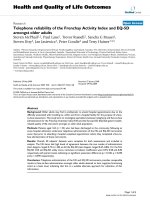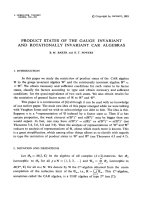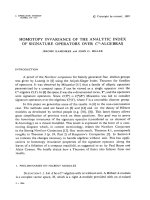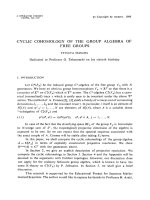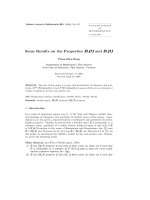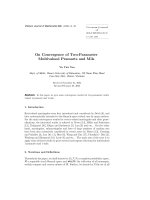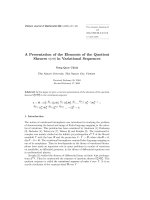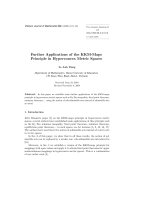Báo cáo toán học: "Dihedral F-Tilings of the Sphere by Equilateral and Scalene Triangles - II" pptx
Bạn đang xem bản rút gọn của tài liệu. Xem và tải ngay bản đầy đủ của tài liệu tại đây (669.08 KB, 21 trang )
Dihedral F-Tilings of the Sphere by
Equilateral and Scalene Triangles - II
A. M. d’Azevedo Breda
∗
Department of Mathematics
University of Aveiro
3810-193 Aveiro, Portugal
Patr´ıcia S. Ribeiro
∗
Department of Mathematics
E.S.T. Set´ubal
2910-761 Set´ubal, Portugal
Altino F. Santos
†
Department of Mathematics
U.T.A.D.
5001-801 Vila Real, Portugal
Submitted: Jun 25, 2008; Accepted: Jul 2, 2008; Published: Jul 14, 2008
Mathematics Subject Classifications: 52C20, 52B05, 20B35
Abstract
The study of dihedral f-tilings of the Euclidean sphere S
2
by triangles and r-
sided regular polygons was initiated in 2004 where the case r = 4 was considered [5].
In a subsequent paper [1], the study of all spherical f-tilings by triangles and r-sided
regular polygons, for any r ≥ 5, was described. Later on, in [3], the classification of
all f-tilings of S
2
whose prototiles are an equilateral triangle and an isosceles triangle
is obtained. The algebraic and combinatorial description of spherical f-tilings by
equilateral triangles and scalene triangles of angles β, γ and δ (β > γ > δ) whose
edge adjacency is performed by the side opposite to β was done in [4]. In this
paper we extend these results considering the edge adjacency performed by the side
opposite to δ.
Keywords: dihedral f-tilings, combinatorial properties, symmetry groups
∗
Supported partially by the Research Unit Mathematics and Applications of University of Aveiro,
through the Foundation for Science and Technology (FCT).
†
Research Unit CM-UTAD of University of Tr´as-os-Montes e Alto Douro.
the electronic journal of combinatorics 15 (2008), #R91 1
1 Introduction
Spherical folding tilings or f-tilings for short, are edge-to-edge decompositions of the sphere
by geodesic polygons, such that all vertices are of even valency and the sum of alternate
angles around each vertex is π. A f-tiling τ is said to be monohedral if it is composed
by congruent cells, and dihedral if every tile of τ is congruent to one of two fixed sets X
and Y (prototiles of τ). We shall denote by Ω(X, Y ) the set, up to isomorphism, of all
dihedral f-tilings of S
2
whose prototiles are X and Y .
The classification of all spherical folding tilings by rhombi and triangles was obtained
in 2005 [6]. However the corresponding study considering two triangular (non- isomorphic)
prototiles is not yet completed. This is not surprising, since it is much harder.
At this moment, the cases are known in which the prototiles are:
- an equilateral triangle and an isosceles triangle, [3];
- an equilateral triangle of side a and a scalene triangle of sides b > c > d, with
adjacency of type I, that is, a = b, [4].
Here our interest is focused on spherical triangular dihedral f -tilings whose prototiles
are an equilateral triangle and a scalene triangle with adjacency of type II (Figure 1).
Figure 1: Adjacency of type II (performed by the side opposite to δ, i.e., a = d).
From now on T
1
denotes an equilateral spherical triangle of angle α
α >
π
3
and side
a and T
2
a scalene spherical triangle of angles δ, γ, β, with the order relation δ < γ < β
(β + γ + δ > π) and with sides b (opposite to β), c (opposite to γ) and a (opposite to δ).
The type II edge-adjacency condition can be analytically described by the equation
cos α(1 + cos α)
sin
2
α
=
cos δ + cos γ cos β
sin γ sin β
(1.1)
In order to get any dihedral f-tiling τ ∈ Ω(T
1
, T
2
), we find useful to start by conside-
ring one of its planar representations, beginning with a common vertex to an equilateral
triangle and a scalene triangle in adjacent positions. In the diagrams that follows it is
convenient to label the tiles according to the following procedures:
(i) The tiles by which we begin the planar representation of a tiling τ ∈ Ω(T
1
, T
2
) are
labelled by 1 and 2, respectively;
the electronic journal of combinatorics 15 (2008), #R91 2
(ii) For j ≥ 2, the location of tile j can be deduced from the configuration of tiles
(1, 2, . . . , j −1) and from the hypothesis that the configuration is part of a complete
planar representation of a f-tiling (except in the cases indicated).
2 Triangular Dihedral F-Tilings with Adjacency of
Type II
Starting a planar representation of τ ∈ Ω(T
1
, T
2
) with two adjacent cells congruent to T
1
and T
2
respectively, see Figure 2, a choice for angle x ∈ {γ, δ} must be made. We shall
consider separately each one of these situations.
Figure 2: Planar representation.
With the above terminology one has:
Proposition 2.1. If x = γ, then Ω(T
1
, T
2
) consists of three discrete families of isolated
dihedral triangles f-tilings (D
p
)
p≥4
, (F
p
)
p≥4
and (E
m
)
m≥5
, such that the sums of alternate
angles around vertices are respectively of the form:
α + β = π, 2α + γ = π and pδ = π, for D
p
, p ≥ 4;
α + β = π, 2γ + α = π and pδ = π, for F
p
, p ≥ 4;
α + β = π, α + 2γ + δ = π and mδ = π, for E
m
, m ≥ 5.
3D representations of D
4
, F
4
and E
5
are given, respectively, in Figures 11,14 and 22.
Proof. In order to have Ω(T
1
, T
2
) = ∅, necessarily α + x ≤ π.
1. Let us assume that α + x = π and x = γ.
In this case, α + β > π and so expanding the configuration illustrated in Figure 2, we
obtain the following one, and consequently δ + β ≤ π.
Let us assume that β + δ = π. As α + γ = π, then by the adjacency condition (1.1),
we conclude that cot α = −cot β. Therefore α <
π
2
and so γ >
π
2
.
The local configuration started in Figure 3 can be extended to the one given in Figure 4.
However at vertex v
1
, the alternate angle sum which contains 2γ does not satisfy the angle
folding relation.
the electronic journal of combinatorics 15 (2008), #R91 3
Figure 3: Planar representation.
Figure 4: Planar representation.
Figure 5: Planar representation.
In case β + δ < π, the angle labelled θ
1
in Figure 3 is δ, otherwise we would have
α + β > π, violating the angle folding relation. Therefore, the configuration gives rise to
the one illustrated in Figure 5.
Looking at the angles surrounding vertex v
2
, one has β + δ + λ > π, for λ ∈ {α, γ, β}.
The angle folding relation is once again, not satisfied.
2. Now, let us assume that α + x < π and x = γ.
Starting from the configuration in Figure 2, we end up with the one given in Figure 6,
with θ
2
∈ {β, δ}.
2.1 If θ
2
= β and α + β = π, then γ + δ >
π
3
and by (1.1) we conclude that α <
π
2
< β.
Now, the sums of the alternate sequence of angles at vertices containing α and γ must
the electronic journal of combinatorics 15 (2008), #R91 4
Figure 6: Planar representation.
be α + γ + λ = π, (Figure 7), where the parameter λ cannot be β and being a sum of
angles (α, γ, δ). The angle α will appear at most once.
Figure 7: Planar representation.
2.1.1 Suppose that λ is a sum of angles with one angle α. Then, 2α + γ ≤ π, but having
in account that 2α + γ + µ > π, for any µ ∈ {α, δ, γ, β} one has 2α + γ = π.
Adding some new cells to the configuration illustrated in Figure 6 we obtain the one
shown in Figure 8.
Figure 8: Planar representation.
Observe that tile 9 must be an equilateral triangle, otherwise the angle folding relation
will be not fulfilled.
One of the alternate angle sums at vertex v
3
is 2α + kδ = π, k ≥ 1 or 2α + γ = π .
Suppose that 2α + kδ = π, for some k ≥ 2. Then, expanding the local configuration
illustrated in Figure 8 we get the one below (Figure 9).
the electronic journal of combinatorics 15 (2008), #R91 5
Figure 9: Planar representation.
At vertex v
4
we observe that the other alternate sum is α + γ + (k − 1)δ + β which is
impossible since it is bigger than π.
Assume now that 2α + γ = π. Choosing one of the possible positions for tile 11, the
extended local configuration started in Figure 8 is the following one.
Figure 10: Planar representation.
The construction of this configuration follows a symmetric pattern with three type
of vertices: the vertices of valency four whose alternate sums are ruled by the equation
α + β = π, the vertices of valency 6 surrounded by the angular sequence (α, α, α, α, γ, γ),
and the vertices of valency 2p whose alternate sums are pδ = π. The parameter p must
be greater or equal to 4, since δ =
π
2
or δ =
π
3
contradicts the adjacency condition. For
p = 4, we obtain a global configuration (Figure 11) of a tiling τ ∈ Ω(T
1
, T
2
), which will
be denoted by D
4
.
The corresponding f-tiling is composed of 16 equilateral triangles and 16 scalene
triangles; and the angles are δ =
π
4
, α = arccos
−1 +
1 + 4
√
2
4
(α ≈ 66.7
◦
) , γ =
π −2α (γ ≈ 46.5
◦
) and β = π −α (β ≈ 113
◦
).
The other possible position for tile 11 gives rise to a similar global configuration of the
tiling D
4
.
the electronic journal of combinatorics 15 (2008), #R91 6
Figure 11: Global configuration and 3D representation of D
4
.
For each p ≥ 4, we obtain a global configuration of a tiling τ ∈ Ω(T
1
, T
2
) with vertices
of valency 4, 6 and 2p composed by 4p equilateral and 4p scalene triangles which, will be
denoted by D
p
, p ≥ 4.
2.1.2 Suppose that λ is a sum of angles containing at least one angle γ. Then, α+2γ ≤ π.
2.1.2.1 If α + 2γ = π, then γ < α and we can expand the local planar representation
illustrated in Figure 6; we obtain one of the configurations illustrated in Figure 12.
Figure 12: Planar representations.
Observe that for tile 6 there are two possibilities for the position of its sides (see Figu-
re 12-I and II). In configuration I, tile 11 is necessarily an equilateral triangle (otherwise,
one of the alternate angle sums at vertex v
5
would be γ + β = π, so that γ = α >
π
3
,
contradicting α+2γ = π) and so vertex v
6
is surrounded by an angular sequence containing
the electronic journal of combinatorics 15 (2008), #R91 7
four adjacent angles α. Accordingly, at this vertex we should have 2α + kδ = π, k ≥ 1
(otherwise we would have γ = α, contradicting α + 2γ = π).
However, the cyclic sequence of angles (α, α, α, α, δ, , δ) around vertex v
6
violates
edge compatibility.
Concerning to the configuration II and taking into account that α + β = π, α + 2γ =
π (γ <
π
3
< α) and β + γ + δ > π (β > γ > δ) we conclude that the alternate sum
containing two angles γ at vertex v
7
must be 2γ + mδ = π, m ≥ 2 or 2γ + α = π.
2.1.2.1.1 If 2γ + mδ = π for some m ≥ 2, the sides arrangement emanating from
vertex v
7
require the other alternate sum to contain one angle α and 1+m angles δ, which
is impossible as illustrated in Figure 13.
Figure 13: Angles arrangement around vertex v
7
.
2.1.2.1.2 If 2γ + α = π, the configuration in Figure 12-II expands globally, and in a
symmetric way, if and only if pδ = π with p ≥ 4. Observe that δ =
π
2
or δ =
π
3
violates
the adjacency condition.
For p = 4, we get a tiling, F
4
, with 8 equilateral triangles and 16 scalene triangles;
and the angles are:
δ =
π
4
, γ = arccos
−
√
2 +
√
34
8
≈ 56.4
◦
, β = π−α ≈ 113
◦
and α = π−2γ ≈ 67
◦
.
For each p ≥ 4, we get a tiling τ ∈ Ω(T
1
, T
2
) with vertices of valency 4, 6 and 2p,
composed by 2p equilateral and 4p scalene triangles, which will be denoted by F
p
, p ≥ 4.
2.1.2.2 If α + 2γ < π
γ <
π
3
< α
, then α + 3γ = π or α + 2γ + δ = π, since from
α + β = π and δ + γ + β > π (β > γ > δ), one has γ + δ > α >
π
3
.
2.1.2.2.1 Suppose α + 3γ = π (Figure 6). Then γ <
2π
9
and β = 3γ. As δ + γ + β > π,
we conclude that δ >
π
9
.
Extending the configuration illustrated in Figure 6, we may add some new cells ending
up with the one illustrated in Figure 15.
Note that there are two possible positions for the sides of tile 6. If we make the choice
shown in Figure 16, the angle θ
3
at vertex v
8
may be α, γ or β. Whichever we choose
β + δ + θ
3
> π and we cannot expand this configuration to a planar representation of an
f-tiling.
the electronic journal of combinatorics 15 (2008), #R91 8
Figure 14: Global configuration and 3D representation of F
4
.
Figure 15: Planar representation.
Figure 16: Planar representation.
The other choice on the sides of tile 6 forces the configuration below (Figure 17).
Tile 8 of Figure 17 is forced in order to avoid the same situation of incompatibility as
the one shown in Figure 16.
the electronic journal of combinatorics 15 (2008), #R91 9
Figure 17: Planar representation.
We conclude that the vertices surrounded by alternate angles β and δ must have at
most four angles δ, since β >
π
2
and δ >
π
9
. By the adjacency condition we have
cos kδ(1 + cos kδ)
sin
2
kδ
=
cos δ − cos kδ cos
π
3
− k
δ
3
sin kδ sin
π
3
− k
δ
3
.
As δ >
π
9
, then k = 2 and δ ≈ 30.9
◦
(for k = 3, 4, we get, respectively, δ ≈ 19.481
◦
, 14.324
◦
,
contradicting δ >
π
9
). Consequently, β ≈ 118.2
◦
, γ ≈ 39.4
◦
and α ≈ 61.8
◦
. The configu-
ration can be expanded ending up at a vertex, v
9
, whose alternate angle sum does not
satisfied β + 2δ = π (see Figure 18).
2.1.2.2.2 Suppose now that α + 2γ + δ = π (Figure 7). Tile 6 can be either a scalene
triangle or an equilateral one.
2.1.2.2.2.1 Assume first that tile 6 is a scalene triangle, as is illustrated in Figure 19.
At vertex v
10
, the alternate sum containing α and δ is
α + kδ = π (k ≥ 4), α + tδ + γ = π (t ≥ 3), α + δ + 2γ = π or 2α + qδ = π (q ≥ 1).
The other alternate sum at vertex v
10
containing γ and δ is
γ + mδ = π (m ≥ 4), γ + α + nδ = π (n ≥ 3), α + δ + 2γ = π or 2γ + pδ = π (p ≥ 1).
Taking into account:
- the angular order relation,
π
3
< α <
π
2
, δ < γ < β, γ >
π
6
, β >
π
2
,
- α + β = π,
- α + 2γ + δ = π and
- the adjacency condition,
the electronic journal of combinatorics 15 (2008), #R91 10
Figure 18: Planar representation.
Figure 19: Planar representation.
we conclude that the alternate angle sums at vertex v
10
are α + γ + tδ = π, t ≥ 3 or
α + 2γ + δ = π, but not both.
2.1.2.2.2.1.1 If α + γ + tδ = π, for some t ≥ 3, the possible positions of γ are the ones
illustrated in Figures 20-I and 20-II.
In angular sequence I, the alternate angle sums are α + γ + tδ = π and γ + tδ + β = π,
which is impossible, as β + γ + δ > π. Thus Figure 20-II illustrates the way vertex v
10
must be surrounded.
Expanding the configuration in Figure 19, we end up with a contradiction at vertex
v
11
, see below (Figure 21).
2.1.2.2.2.1.2 Suppose now that one of the alternate angle sums at vertex v
10
is α +
2γ + δ = π. Expanding the configuration in Figure 19 we may deduce the existence of
vertices surrounded uniquely by angles δ and so δ =
π
m
. Since δ < γ < α, we conclude
that m ≥ 5.
the electronic journal of combinatorics 15 (2008), #R91 11
Figure 20: Angles arrangement around vertex v
10
.
Figure 21: Planar representation.
For any m ≥ 5, we obtain an f-tiling E
m
that has one class of vertices of valency 4,
one of valency 8, and one of valency 2m, being composed of 4m equilateral triangles and
8m scalene triangles. A 3D representation for m = 5 is illustrated in Figure 22.
2.1.2.2.2.2 Suppose now, that tile 6 (Figure 7) is an equilateral triangle. Adding some
new cells to the illustrated configuration, we get a vertex, v
12
, surrounded by the angular
sequence (α, γ, δ, β), which does not satisfy the angle folding relation (Figure 23).
2.1.3 Suppose that λ is a sum of angles containing δ. Then, α + γ + δ ≤ π.
If α + γ + δ = π, from the configuration in Figure 7, tile 6 has two possible positions,
see below (Figure 24).
In any of theses cases, we get the alternate angle sum β + 2γ = π, which is impossible
since β + 2γ > β + γ + δ > π.
Therefore, α + γ + δ < π. As the case α + γ + δ + γ = π was just studied, we assume
that α + γ + tδ = π, for some t > 2. Pursuing the expansion of the configuration given
in Figure 7, we end up with a vertex v
13
surrounded by a cyclic sequence of angles of the
form (γ, γ, α, γ, δ, δ, , δ, β), which is a contradiction since β + γ + δ > π, see Figure 25.
the electronic journal of combinatorics 15 (2008), #R91 12
Figure 22: 3D representation of E
5
Figure 23: Planar representation.
Figure 24: Planar representations.
2.2 If θ
2
= β and α + β < π (Figure 6), then α + β + γ = π or α + β + kδ = π, k ≥ 1,
since α, β >
π
3
and γ >
π
6
.
Suppose that α + β + γ = π. Then δ > α >
π
3
, which is an impossibility.
If α + β + kδ = π, k ≥ 1, the configuration illustrated in Figure 6 can be expanded
to the one below (Figure 26), according to a choice for the edge position of tile 6. This
choice ends up in a contradiction, since 2β + ρ > π, for any ρ ∈ {α, δ, γ, β}.
the electronic journal of combinatorics 15 (2008), #R91 13
Figure 25: Planar representation.
Figure 26: Planar representation.
Observe that the other possible position for tile 6 leads to an alternate angle sum of
the form γ + β + µ = π, for some µ. Nevertheless γ + β + µ > π, for each µ ∈ {α, γ, δ, β}.
2.3 If θ
2
= δ (Figure 6), then α + δ < π, since α + γ < π and δ < γ. Consequently,
β + δ ≤ π. If β + δ = π, then β + γ > π and the configuration in Figure 27 exhibits a
contradiction at the vertex surrounded by the sequence of angles α, β, δ, γ.
Figure 27: Planar representation.
Therefore, β + δ < π. The configuration is now (Figure 28):
A decision about the angle labelled θ
3
∈ {γ, δ} must be taken.
2.3.1 If θ
3
= γ, then the alternate sum containing β and γ at vertex v
14
is β + γ = π or
β + γ + α = π. However, if β + γ = π, the other alternate sum would be α + δ = π, which
is a contradiction. Therefore, β + γ + α = π, but since β + γ + δ > π, then α < δ < γ,
which is an impossibility.
2.3.2 If θ
3
= δ, then looking at vertex v
15
in Figure 29, the alternate sum containing β
must be of the form β + α + nδ = π, n ≥ 1.
Observe that β ≥
π
2
, otherwise, δ < γ < β <
π
2
and taking into account the adjacency
the electronic journal of combinatorics 15 (2008), #R91 14
Figure 28: Planar representation
Figure 29: Planar representation.
condition, we would have α <
π
2
, which is impossible, since vertices of valency four must
occur. In fact, any f-tiling τ ∈ Ω(T
1
, T
2
) has at least six vertices of valency four as
established in [5].
2.3.2.1 Considering β =
π
2
, then δ < γ <
π
2
, γ >
π
4
and once again by the adjacency
condition α <
π
2
.
On the other hand, the sequence of alternate angles containing α and γ, at vertex v
16
,
satisfy 2α + γ = π or α + 2γ = π or α + γ + tδ = π, t ≥ 2.
If 2α + γ = π, then γ <
π
3
and δ >
π
6
. But from β + α + nδ = π, for some n ≥ 1,
which is a contradiction.
If α + 2γ = π, the same argument is valid. Therefore, α + γ + tδ = π, t ≥ 2 and the
configuration illustrated in Figure 29 can be extended to the one shown in Figure 30.
As we also have β +γ +µ > π for any µ ∈ {α, δ, γ, β}, there is only one way to arrange
the sides of the tile numbered 7.
Looking at vertex v
16
, we conclude that the other sequence of alternate angles must
have one angle β, which is impossible.
2.3.2.2 Considering now that β >
π
2
, since β + δ < π, β + α < π and α + γ < π, the
alternate angle sums at vertices of valency four are β + γ = π or 2γ = π.
If γ =
π
2
, then β > γ > α > δ and so α + γ + mδ = π, for some m ≥ 2 at vertex
v
16
(see Figure 29). The edge length compatibility forces the existence of an angle β at
the electronic journal of combinatorics 15 (2008), #R91 15
Figure 30: Planar representation.
vertex v
16
, which is a contradiction since β + γ > π.
Summarizing, we have β +γ = π and β +α +nδ = π; (n ≥ 1) and so γ > α >
π
3
, which
means that a sequence of alternate angles at vertex v
17
is α, γ, δ, , δ. Adding some new
cells to the configuration in Figure 29, we conclude that there is an angle β surrounding
vertex v
17
, which is an impossibility since we have β + γ + γ > π (see Figure 31).
Figure 31: Planar representation.
Proposition 2.2. If x = δ (Figure 2) , then Ω(T
1
, T
2
) = ∅.
Proof. Assume first that:
1. α + x = π and x = δ.
If α ≤
π
2
, then δ ≥
π
2
and consequently β > γ >
π
2
, turning impossible any expansion
of the configuration shown in Figure 2.
Therefore, α >
π
2
, δ <
π
2
and by the adjacency condition γ <
π
2
and β >
π
2
.
The configuration illustrated in Figure 2 can be extended to the following one (Figu-
re 32).
the electronic journal of combinatorics 15 (2008), #R91 16
Figure 32: Planar representation.
As α + δ = π = β + γ and γ > δ, then α > β. Accordingly, α > β >
π
2
> γ >
δ and by the adjacency condition we conclude that −cos α − cos
2
β < 0. However,
0 < cos
2
β < −cos β < −cos α and consequently −cos α − cos
2
β > 0, which is a
contradiction. Therefore, the configuration illustrated in Figure 32 does not extend to an
f-tiling τ ∈ Ω(T
1
, T
2
).
2. If α + x < π and x = δ, a decision must be taken about the angle θ
1
∈ {β, δ} in
Figure 33.
Figure 33: Planar representation.
2.1 If θ
1
= β, then the alternate sum containing β and γ at vertex v
1
is β + γ + α = π,
but since β + γ + δ > π, then
π
3
< α < δ < γ, which is an impossibility.
2.2 If θ
1
= δ, we can add a new cell to the configuration and obtain the one in Figure 34.
Figure 34: Planar representation.
A decision about the angle θ
2
∈ {δ, β} must be taken.
the electronic journal of combinatorics 15 (2008), #R91 17
2.2.1 If θ
2
= δ, the configuration illustrated in Figure 34 expands and gives rise to the
one in Figure 35.
Figure 35: Planar representation.
Consider the alternate angle sum containing β and γ at vertex v
2
. This sum must be
β + γ = π. We have at the same vertex another alternate angle sum which is α + δ = π,
contradicting our assumption.
2.2.2 If θ
2
= β, then α + β ≤ π and consequently γ + δ >
π
3
.
2.2.2.1 Let us first analyze the case α + β = π. We shall consider separately the cases
α + β = π and α + β < π. By the adjacency condition, we have α <
π
2
< β.
Consider the alternate angle sum containing γ and δ at vertex v
1
(Figure 34). Taking
into account the relation between angles and the edge lengths compatibility it can be seen
that this sum must be of the form α + γ + nδ = π, n ≥ 1 or α + 2γ + δ = π.
2.2.2.1.1 In the first case, the configuration in Figure 34 extends to the following one
(Figure 36).
Figure 36: Planar representation.
Looking at vertex v
2
, the alternate sum containing two angles α is 2α + γ = π or
2α + pδ = π, p ≥ 1. In case, 2α + γ = π the configuration ends up in to the one illustrated
in Figure 37.
However, the sequence of alternate angles containing γ and β, at vertices v
3
and v
3
,
must satisfy β + γ = π, which is a contradiction since β + α = π and 2α + γ = π. Observe
the electronic journal of combinatorics 15 (2008), #R91 18
Figure 37: Planar representation.
that due to tile 11, tile 13 must be an equilateral triangle in order to avoid two alternate
angles β.
In case 2α + pδ = π, p ≥ 1, the sequence of angles at vertex v
2
must be the one in
Figure 38 and the alternate sequence of angles containing α and γ must contain one angle
β, which is an impossibility since α + γ + β > π.
Figure 38: Angles arrangement around vertex v
2
2.2.2.1.2 If α + 2γ + δ = π (vertex v
1
, Figure 34), then the local planar representation
extends to one of the configurations illustrated in Figure 39, accordingly to the edge
position for tile label by 8.
In the first situation a vertex surrounded by three consecutive angles α takes place.
As α > γ, then α + mδ = π, m ≥ 1 must be an alternate angle sum at this vertex. Taking
in account the edge length, there is a contribution of an angle β surrounding such vertex
leading us to a contradiction.
In the second case, the local configuration is uniquely extended to a global represen-
tation of the f-tilings E
m
, m ≥ 5, described before.
2.2.2.2 Consider now that α + θ
2
< π, with θ
2
= β (see Figure 34).
Then, necessarily α+β +tδ = π, t ≥ 1. The configuration in Figure 34, ends up, according
to a choice of the edge position of tile 7, to the one illustrated below (Figure 40). It reveals
one alternate angle sum at vertex v
4
containing β, γ and δ, which is impossible.
the electronic journal of combinatorics 15 (2008), #R91 19
Figure 39: Angle arrangement around vertex v
2
Figure 40: Planar representation.
Observe that the other choice for the position of tile 7 implies that one of the alternate
angle sums at vertex v
4
is 2β + tδ = π, t ≥ 1, which is an impossibility.
3 Symmetry Groups
Here we present the group of symmetries of the spherical f-tilings obtained: D
p
, F
p
(p ≥ 4)
and E
m
(m ≥ 5). We also indicate the transitivity classes of isogonality and isohedrality.
In Table 1 it is shown a complete list of all spherical dihedral f-tilings, whose prototiles
are an equilateral triangle T
1
of angle α and a scalene triangle T
2
of angles δ, γ, β,
(δ < γ < β). We have used the following notation.
• M and N are, respectively, the number of triangles congruent to T
1
and the number
of triangles congruent to T
2
used in such dihedral f-tilings;
• G(τ) is the symmetry group of the f-tiling τ . The numbers of isohedrality-classes
and isogonality-classes for the symmetry group are denoted, respectively, by # isoh.
and # isog.;
the electronic journal of combinatorics 15 (2008), #R91 20
• By C
n
and D
n
we denote, respectively, the cyclic group of order n and the dihedral
group of order 2n.
• α = α
p
1
, p ≥ 4 is the solution of (1.1) with p δ = π, β = π − α and γ = π − 2α;
• α = α
p
2
, p ≥ 4 is the solution of (1.1) with p δ = π, β = π − α and γ =
π
2
−
α
2
;
• α = α
m
3
, m ≥ 5 is the solution of (1.1) with m δ = π, β = π−α and γ =
π
2
−
α
2
−
π
2m
.
f-tiling α δ γ β M N G(τ ) # isoh. # isog.
D
p
, p ≥ 4 α
p
1
π
p
π − 2α π − α 4p 4p D
2p
3 3
F
p
, p ≥ 4 α
p
2
π
p
π
2
−
α
2
π − α 2p 4p C
2
× D
p
2 3
E
m
, m ≥ 5 α
m
3
π
m
π
2
−
α
2
−
π
2m
π − α 4m 8m D
2m
4 3
Table 1: The Combinatorial Structure of the Dihedral F-Tilings of the Sphere by Equilateral
and Scalene Triangles with adjacency of type II
References
[1] Catarina P. Avelino and Altino F. Santos, Spherical F-Tilings by Triangles and r-Sided
Regular Polygons, r ≥ 5, Electronic Journal of Combinatorics, 15(1) (2008), #R22.
[2] A. M. d’Azevedo Breda, A class of tilings of S
2
, Geometriae Dedicata, 44 (1992),
241–253.
[3] A. M. d’Azevedo Breda, Patr´ıcia S. Ribeiro and Altino F. Santos, A class of spherical
dihedral f-tilings, European Journal of combinatorics, accepted for publication.
[4] A. M. d’Azevedo Breda, Patr´ıcia S. Ribeiro and Altino F. Santos, Dihedral f-tilings of
the Sphere by Equilateral and Scalene Triangles-I, submitted for publication.
[5] A. M. d’Azevedo Breda and Altino F. Santos, Dihedral F-Tilings of the Sphere by
Spherical Triangles and Equiangular Well Centered Quadrangles, Beitr¨age Algebra
Geometrie, 45 (2004), 441–461.
[6] A. M. d’Azevedo Breda and A. F. Santos, Dihedral f-tilings of the sphere by rhombi
and triangles, Discrete Math. Theoretical Computer Sci., 7 (2005), 123–140.
[7] S. A. Robertson, Isometric folding of riemannian manifolds, Proc. Royal Soc. Edinb.
Sect. A, 79 (1977), 275–284.
the electronic journal of combinatorics 15 (2008), #R91 21

